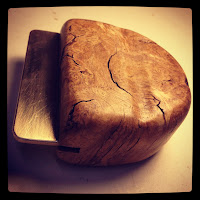I must admit that this week has been rough. After two whole days of routing and a full day of sanding, I seem to have not gotten much further on my project. On top of that, we've had the neigh impossible task of making the dovetails in our apprentice boxes by hand. I've found the process pretty demoralising, as despite all the will in the world, I just can't seem to make mine flush.
My head knows that one does not become an expert woodworker overnight, just because you happen to have enrolled in woodworking school, and that it will take time for my skills to develop to an acceptable level. It also knows that for someone who has only this year picked up a saw, hammer and plane I am doing pretty well just keeping up with the course and bashing these out on target. But head and heart don't seem to be communicating too well at the moment, and so here I am a little down on myself for not getting them perfect. Because they should be. And God knows its not for a lack of trying.
Thankfully though, a trip back to civilisation this weekend and some time off to attend a lovely wedding has given me a bit of space to reflect on all that I've achieved in the last month and to remember why I am doing all of this. So despite the grubby chimney sweep fingers, and the aches, pains and scrapes I've accumulated in the last month (my little hands are sadly still sore and swollen notwithstanding the impromptu hand massage at said wedding - a long story which I will save for another day), I find myself looking forward to the start of another week. Although if I never have to do another dovetail again I won't be too upset by it!
 |
| Some sawdust and glue to fill in the gaps. |
 |
| Accursed dovetails |



















